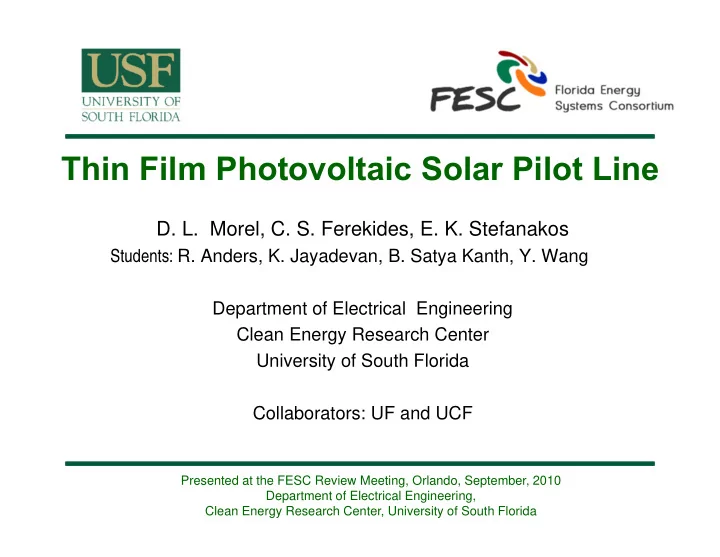

Thin Film Photovoltaic Solar Pilot Line D. L. Morel, C. S. Ferekides, E. K. Stefanakos Students: R. Anders, K. Jayadevan, B. Satya Kanth, Y. Wang Department of Electrical Engineering Clean Energy Research Center University of South Florida Collaborators: UF and UCF Presented at the FESC Review Meeting, Orlando, September, 2010 Department of Electrical Engineering, Clean Energy Research Center, University of South Florida
Project Overview Objectives: Establish a world-class thin film PV module capability Attract PV manufacturing operations to the state Project Plan: Design, build and operate a state-of-the- art generic thin film module facility 2 TASK 3 DFT Modeling
Project Overview Milestones/ Timeline : Year 1 - Facility operational, sub-module experiments underway Year 2 – Processing equipment operational, module level processing underway Year 3 – Demonstration of effective module fabrication and performance, industry participation 3
Project Overview Milestones/ Timeline : Year 2 – Processing equipment operational, module level processing underway Formed partnership with Florida based Mustang Solar • Deposition system budget leveraged by x5 • Switched to RTR Processing • SS substrate development underway 4
Mustang Solar RTR Coating Machine 5
6 Discrete Cell Production
7 RTR Monolithic Integrated
8 Solar PV Laboratory
Solar PV Laboratory Capabilities Cell and Module Fabrication • Cell strings on SS roll • Interconnection and packaging into modules • Monolithic integration in a later phase Physical Vapor Deposition • Sputtering, Evaporation, Close Space Sublimation In-Situ Diagnostics • SS integrity, composition and thickness monitoring Stability Testing 9
Selenization Pathways to 2SSS CuInGaSe 2 Manufacturing 2SSS : 2 Step Solid Source(Se) • Highest efficiencies attained with 2- or 3-step process • Sticking coefficient for Se is low → excessive Se use • Volatile Ga species form with Se → loss of Ga 10
Selenization Pathways to 2SSS CuInGaSe 2 Manufacturing Se Incorporation • Se incorporation is a function of substrate temperature(Tss) and Se/metal flux • Approximately 50 atomic % Se is required • In the first step of a 2SSS process Cu/Ga > 1 is required and a Tss of 300 °C is used which requires a Se/metal flux of order 6 to reach 50% Se 11
Selenization Pathways to 2SSS CuInGaSe 2 Manufacturing Proprietary Process Developed • Co-deposition produces highest efficiency but is most difficult to manufacture • Precursor Selenization is easier to manufacture but lower efficiency • Se and Ga have a complex incorporation interdependence which results in inefficient incorporation • New process spans the range in Se and Ga utilization between the two “endpoint” processes 12
Selenization Pathways to 2SSS CuInGaSe 2 Manufacturing Proprietary Process Provides Additional Control • Additional control of the proprietary process maintains 50% Se content over a range of Cu/Ga ratios • 50% Se can be attained at Cu/Ga of 1.7 compared to a value of 2.8 for co- deposited films indicating a significant reduction in Ga loss • Allowing a small increase in Cu/Ga from 1.7 to 2.1 results in significant reduction in Se flux ratio from 5 to 3 while maintaining Se at 50% 13
Conclusions • A partnership with a Florida based industrial partner has been formed • The main processing tool for the thin film pilot line is being built with x5 leveraging of budgeted funds • The processing approach has been switched to roll-to-roll on a stainless steel web • Lab scale experiments are being conducted to develop new processing pathways • A proprietary process for improved control and utilization of Ga and Se has been developed 14
Recommend
More recommend